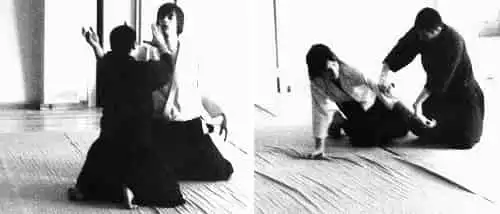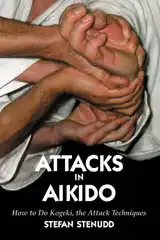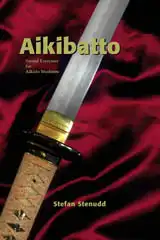Aikido is true Me as an adolescent, experimenting wildly with training buddy Lennart Linder, c.1974. What Made Me Start and Continue with AikidoI was seventeen when I first heard about the remarkable Japanese martial art aikido. It was Krister, a friend some years my senior, who told me that he had practiced it. Just how seriously he regarded Aikido, I understood partly from how long he had taken to reveal his knowledge of it — although he must be convinced that it would impress a teen age boy — and partly from his elaborate and solemn way of talking about it. What Krister described was something completely different from a series of tricks to defeat an opponent of twice one's own size, also something different from the concept of athletics for a sound mind in a sound body. What Krister described was a way of living — an art, a philosophy, yes, kind of a religion. After listening with widening eyes to Krister's equally fascinating and incomprehensible elaboration on the subject, I had to make him show me just how it worked. Also with this he was remarkably reluctant. When I had repeated my wish over and over, he conceded and showed me one of the simpler techniques, nikyo, wherein my wrist was turned in such a way that I fell to the floor in sudden pain. My wrist hurt as if it were broken, although it was unharmed, and surely my knees had been bruised from the sudden fall to the floor, but I was overcome by one thing only: the beauty of the technique. Krister had only turned his hand around mine, as simply as the butterfly, when sitting on a straw of grass, gently flaps its wings. That was all. And I fell to the floor as abruptly as if I were hit with a blacksmith's hammer. It was delightful, in the midst of the pain. It was magical, incomprehensible although it looked so simple. This I wanted to learn. When the beginner's course started in the fall, I showed up in my blue gym suit, anxious and excited.
 Me as uke for Ichimura in a Jakobsberg aikido class, c. 1973. Like a darkening sky, where one star after the other becomes visible to the eye, Aikido has through the years revealed increasing riches to me. Yet I think that the teen age boy who fell suddenly to the floor by Krister's nikyo, really saw absolutely everything that the years of training have since made me acquainted to. Everything was present in that first, painful encounter. What followed was neither more nor less than confirmations — delightful confirmations.
My demonstration at the national seminar of 2002, when Swedish aikido celebrated 50 years. Uke is Jonas Dahlqvist. However exotic some of the Aikido movements may be, they are permeated by a sense of recognition. When you pull it off alright and the technique works somewhat, it's not at all like a foreign term you've finally learned by heart, after hours of repetition. No, it's an old friend making his entrance, or a small muscle that has rested for a long time but is once again put to work. All the secrets of Aikido are dèja vu — they are recognizable. How can this be? Maybe we must say like Plato, that man cannot learn anything he did not essentially know from the beginning. All wisdom is contained in our heads from the very moment of birth, we only have to be reminded of it. That's not a bit more odd than the thesis that something must come out of something, never out of nothing.
Playing with aikido techniques on handshakes, filmed in 2017. Many more aikido videos on my YouTube Channel.
What is true, completely true, is immediately recognized by every human being — if he just wants to. So, if my senses were at all to be trusted, I knew from the first moment: Aikido is true.
Stefan Stenudd
AIKIDO PRACTICEIntroductionAikido Techniques — all the basic movesAttacks in Aikido
Tantodori — knife defenseAikiken — aikido sword techniquesJo 31 Kata in four directionsAikibatto sword and staff exercisesAiki — joining energiesKi exercisesAikido Video ClipsAikido PhotosMy aikido dojo in Malmö, SwedenMy aikido seminarsAIKIDO THEORYMy Aikido BioAikido GlossaryTanden, the CenterAikido InksAikido as Self-DefenseRunning a DojoAikido is TrueOsensei and EinsteinAikiWeb ColumnsAikido Books ReviewedDie deutsche Version meines Aikido-Buches onlineAikido på svenskaAbout CookiesMy Other WebsitesCREATION MYTHSMyths in general and myths of creation in particular.
TAOISMThe wisdom of Taoism and the Tao Te Ching, its ancient source.
LIFE ENERGYAn encyclopedia of life energy concepts around the world.
QI ENERGY EXERCISESQi (also spelled chi or ki) explained, with exercises to increase it.
I CHINGThe ancient Chinese system of divination and free online reading.
TAROTTarot card meanings in divination and a free online spread.
ASTROLOGYThe complete horoscope chart and how to read it.
MY AMAZON PAGE
MY YOUTUBE AIKIDO
MY YOUTUBE ART
MY FACEBOOK
MY INSTAGRAM
MY TWITTER
STENUDD PÅ SVENSKA
|
 Aikido Principles
Aikido Principles Attacks in Aikido
Attacks in Aikido Aikibatto
Aikibatto
